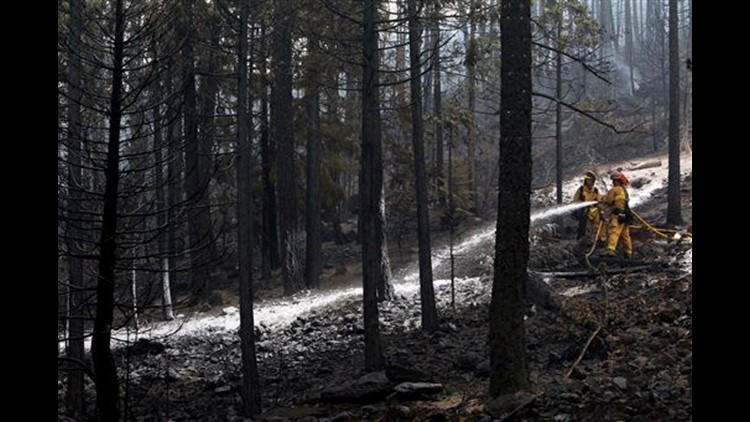BURNEY, Calif. (AP) — Wildfires, like earthquakes, are a frightening fact of life in California, just more predictable. So as thousands of firefighters made progress in taming more than a dozen blazes that have pockmarked the northern half of the state, fire officials and anxious residents of drought-afflicted rural communities breathed a shallow sigh of relief they knew might not last long.
Light rain and an infusion of personnel and equipment from as far away as San Diego allowed fire crews to gain momentum Tuesday on a pair of wildfires that exploded over the weekend in a national forest filled with moisture-starved fallen trees, U.S. Forest Service spokesman Jim Mackensen said. The two fires burning about 7 miles apart in Shasta and Lassen counties were among nine major wildfires that erupted in a 24-hour period last week, most sparked by lightning.
Firefighters "are a finite resource, and we hit all the fires that we can as quickly as we can and we are successful most of the time keeping the fires at less than 10 acres," Mackensen said. "When you get that many fires in remote locations and they all hit at once, we ran out of folks essentially, so they got bigger and we had to play catch-up a little bit."
Eight homes, a historic post office and a restaurant were lost in the smaller of the two fires that started in Lassen National Forest, and a town of 3,000 and its electrical supply remained threatened. But the spread of the second blaze had slowed enough that people living in its path who had been evacuated since Friday night were allowed to return home on Tuesday afternoon.
Cooler temperatures and scattered showers also helped firefighters hold the line on four fires that have torched 51 square miles of wilderness and range and prompted evacuations in the state's farthest reaches, including one that started in Oregon.
The precipitation was a mixed blessing, however, since thunderstorms forecast for Northern California and Southern Oregon could bring winds that would exacerbate existing fires and lightning that could cause new ones. And after Wednesday, the regions were expected to heat up again through next week. In Washington, two large fires grew amid warnings of strong winds and low relative humidity on Tuesday.
"We are not out of the woods yet," Mark Ghilarducci, director of the California Office of Emergency Services, said after surveying the Shasta and Lassen fires from a helicopter on Tuesday. "This event is the kind of thing we have been talking about all year, and it's not unexpected that we will be in these conditions again this summer, so this is not a one-off."
Officials in California, Oregon and Washington have been warning the public about a heightened danger for summer wildfires because of unusually dry conditions and above normal temperatures, so the latest flurry did not come as a surprise. In Northern California, air and ground fire crews have been staffed at peak levels and on high alert since the spring, so when the weekend blazes broke out, "we just threw everything we could at them," Ghilarducci said.
"I have to tell you, it could have been a heck of a lot worse," he added. "If we were in more populated areas, there would have been greater losses."
Along with leaving forests, mountain passes, hillsides and canyons critically dehydrated, the drought made it harder for aerial fire crews to secure water to douse the flames of the last few days, fire officials said. Some of the reservoirs, lakes and ponds closest to the wildfires either were empty or too shallow for helicopters to dip their buckets into, so they had to fly greater distances to refill, which slowed firefighting efforts.
The National Interagency Fire Center in Boise, Idaho said Tuesday that there have been fewer wildfires than usual across the nation so far this year and they have burned a combined area that is less than half the size of the 10-year average. In the West, however, it's a different story.
In Oregon and Washington, the number of fires is running 15 percent above average and they have consumed nearly three times as much land.
Fire activity in Northern California is at 123 percent of average, but the amount of acreage left blackened is almost half of the decade average since many of the blazes have been small.
In Southern California, where the worst fires typically come with the fall Santa Ana winds, the number of fires has been just under average and the number of acres burned two-thirds below average.
The fire center predicted this month that given the record dry fuels on forest floors and no significant rain in the forecast, the potential for significant fires will remain high in California, Oregon and Washington though at least September. But drought, or the absence of it, is only one of the factors that drives destructive fires, spokesman Mike Ferris said.
"The stage is set for large, intense wildfires in many areas due to long-term factors, such as climate change, hazardous fuel buildups, insect and disease outbreaks, invasive species infestations, and drought," Ferris said. "When short-term weather conditions come into play - such as above-average temperatures, low relative humidities, high winds, and lightning, we can expect to see extreme fire behavior."
Copyright 2014 The Associated Press. All rights reserved. This material may not be published, broadcast, rewritten or redistributed.



